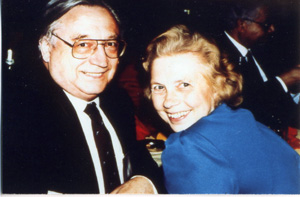Annerose und Fritz Anders
Interview
Curriculum Vitae
Annerose Anders
Wiss. Werdegang:
- 1948: Hochschulreife in Spremberg (Land Brandenburg)
- 1948-1955: Studium der Naturwissenschaften in Potsdam und Mainz.
- 1956: Promotion in Mainz bei H. Mislin, G. deLattin, F. Strassmann
Fritz Anders † 21.12.1999
General Data
Dr. rer. nat. Fritz Wllbelm Anders, o. em. Professor of Genetics at the University of Giessen, was born Nov. 22, 1919 in Berlin, Germany, and grow up in WentdorflWittenberge atthe EIbe river, Prussia. In 1938 J was qualified for the admission to a university but was drawn as ArbeilSmann and soldier in the second world war. 1943·1948 I was prisoner of war in Russia. Since 1954 I am married to the geneticist Dr. rer. nat. Annerose Anders who is working as a private group leader in genetics with me.
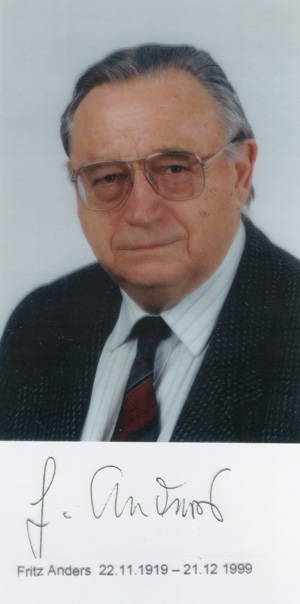
Professional Career
1949-1951 I studied Education in Potsdam (East Gerrnany). Tbereafter I moved to the University of Mainz (West Germany), studied Biology, worked 00 my doctoral thesis on polygenie sex determination in submammalien systems and earned in 1954 the degree of a Dr. rer. nat. After a four years work on plant tumors at the grape breeding institute Geilweilerhof (Palatinate) I was qualified as Privatdozent and Professor of Genetics at the University of Saarbrücken by submission of an inaugural dissertation on susceptibility, resistence and tolerance of grape plants to plant galls and plant tumors. In 1964 J was appointed as founder and Director of the Genetics Institute of the University of Giessen. Since 1988 I am retired from the directorship but continue working and teaching on comparative cancer genetics.
Activity in Professional Societies
I am a member of the
- German Genetics Society (I am one of its refounders after world war II, was it´s secretary and president).
- Genetics Society of America,
- American Association for Cancer Research (Corresponding Member),
- International Pigment Cell Society (Member of the board of directors; Honorary Member since 1997),
- International Academy of Tumor Marker Oncology (Co-founder),
- German Cancer Society.
- Naturforscher Leopoldina (a German based, venerable Academy of Scientists of the world),
- German Society of Biochemistry and Molecular Biology,
- German Zoological Society. -
Among several German scientific conferences I organized the 1985 International Meeting of the International Pigment Cell Society in Giessen, Germany (Proceedings in Pigment Cell 1985, University of Tokyo Press).
Editorial and Otber Actiyities
I served or serve, respectively, in the Editorials of
- International Journal of Oncology
- Journal of Tumor Marker Oncology
- Pigment CeU Research
- Melanoma Research
- Critical Reviews in Oncogenesis
Through many years I was consultant for the Deutsche Forschungsgemeinschaft and a group leader in the Sonderforschungsbereich "Cell Energetics and Cell Differentiation" at the University of Marburg.
Awards
I am a recipient of the
- Myron Gordon Award 1983 of the International Pigment Cell Society (together with A. Anders .. in recognition of' our "distinguished contributions toward an understanding of the genetics of normal and atypical pigment cells"),
- Dr. Emil Salzer Preis far Cancer Research 1984, Baden-WUrttemberg and Cancer Center Heidelberg (together with A. Anders for our work on the genetic basis of cancer development),
- Gonron-JustWissenschaftspreis of the University of Ulm 1984 (for my work on gene regulation in cancer development),
- Deutscher Krebspreis 1993 (Deutsche Krebsgesellschaft. theoretischer Teil, together with A. Anders; for the biologica1 identification of oncogenes and suppressargenes in the Xiphophorus fish tumor model that led to the detection of mammalian and human oncogenes and suppressorgenes),
- The Prince Hitachi Prize for Comparative Oncology 1997 (The Japanese Foundation for Cancer Research).
Honourable Lectures
- A Biologist's View of Human Cancer: The Dr. Mildred Scheel Memorial Lecture 1988, Hamburg, Germany in: R. Neth, R.C. Gallo et al. (eds), Modern Trends in Human Leukemia VIII. Springer-Verlag Berlin-Tokyo, 1989, pp 23-45. - Mildred Scheel, the late wife of the Bundespresident of the Deutsche Bundesrepublik, was a benefactress for Cancer Research in Germany.
- Contributions of the Gordon-Kosswig Melanoma System to the Present Concept of Neoplasia. - Tbe Myron Gardon and Curt Kosswig Tribute Lecture 1990, in Kobe, Japan. In: Pigment Cell Research 3: 7-29,1991
Career in Cancer Research
Towards Oncogenes and Suppressorgenes.
While still working on the cecidogenic (tumor inducing) principle of grape plants I started my career in basic cancer research in 1958 at the Xth International Congress of Genetics in Montreal. Canada. Here I met Myron Gardon from the New York Museum exhibiting melanoma hearing killifish (genus Xiphophorus) that he eould continuously produee and propagate by crossings of spotted platyfish with swordtails.
With fish provided by Gordon I, together with A. Anders and my students, subsequently continued Gordon's crossing experiments and proceeded analyzing genetic, cytologic and biochemic events related to tbe outgrowth of spots to melanoma. In 1962 (F. Anders et a1., Festschrift für Hans Stubbe, Biol. Zb1.81, 45-65) it became c1ear that formation and inheritance of a) spots of the platyfish and b) melanomas of the hybrids follow the segregation of the same Mendelian gene present at a distinct site of a platyfish-derived chromosome but lacking in the genome of the swordtail. We called this gene, which is an "oncogene" by modem definition, "tumor gene". Another Mendelian gene located on a different chromosome of the platyfish turned out to be a counterweight to the tumorgene keeping the spots in rein in the purebred animals but permitting tbe spots to grow out to melanoma if it gets lost by Mendelian segregation in the hybrids. We called this gene, which is a "tumor suppressorgene" by modem definition, "controller" or "regulatory gene" for the tumor gene. Crossing-conditioned loss of the controller to heterozygousity results in benign melanoma; its loss to homozygous absence results in malignant melanoma. Later on it was shown (F. Anders et al ., Modern Trends in Human Leukemia 1985, Springer, 186-206) that these are the genes that carcinogens act upon. The Biology of an Oncogene, Based Upon Studies on Neoplasia in X@hophorus
Towards the Molecular Oncogene-Suppressorgene Machinery
In 1967 we confirmed the results of our first ten years' phase of research with the review "Tumour Formation in Platyfish-Swordtail Hybrids as a Problem of Gene Regulation" (Experientia 23: 1-10). In retrospect, this paper marks the key for the modern focus on genetics causation of neoplasia and its branching to the concept of the molecular Oncogene-Suppressorgene Machinery. The melanoma determining loci (oncogenes) and their controllers (tumor suppressorgenes) were localized (A. Anders et al., in: J .H. Schröder, ed., Genetics and Mutagenesis of Fish, Springer-Verlag, Berlin, 1973, pp 31-52 and pp 53-63). Stable hybrid genotypes that develop hereditary thyroid adenocarcinoma, reticulosarcoma, neuroblastoma and other neoplasms that follow the same genetic principle as found in melanoma were selected. The personal encouragement by Hans Stubbe, Curt Stern, Curt Kosswig, Ernst Caspari, Arnold Graffi, Jaek Schultz, David Prescott and some younger scientist in the upcoming molecular cancer research prompted us in 1977 to propose the appearance of human melanoma, retinoblastoma, Wilm's tumor, phaeochromocytoma, tumors of breast, ovaries, stomach and colon as loss or impairment of oncogene-specific suppressorgenes (Cancer as a Problem of Gene Regulation, in R.C.Gallo [ed.], RecentAdvances in Cancer Research, CRC Press, pp. 103-117,1977).
We completed this period of our research in 1989 with an elaboration of the evolutionary tree of 20 oncogenes from sponge, sea anemone, cuttle fish, Limulus, Amphioxus, lamprey. shark, Xiphophorus, frog, snake, chicken, mause, pig, up to humans in the above mentioned lecture to the memory and honer to Dr. Mildred Scheel: "A Biologist's View of Human Cancer".
The Molecular Biology of the Oncogene/Suppressorgene Mochinery
In 1982, R. Gallo, K.Toyoshima, N. Cleary and R. Müller provided us with over 20 cloned oncogenes, and we concentrated on the molecular identifiation of the responsibility of particular ancogenes for the causation of particular types of tumors. In the xiphophorine melanoma we found tbe first convincing correlation between the inheritance and the expression of the v-src-related xiphophorine x-sre gene (Cancer Research 42:2429-2433; 4222-4227, 1982).
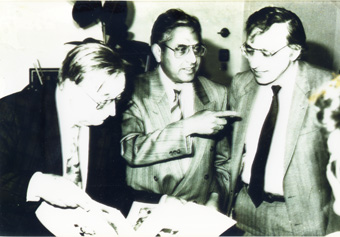
Our extending molecular experiments still could not identify x-src and any other oncogene as the expected determinant that on would term a melanoma gene or, in other analyses, a neuroblastoma gene, retinoblastoma gene, fibrosarcoma gene ete., while laboratories working on similar problems thought tbey did. However, in 1988, Christina Zechel of our laboratory fallod an accessory xiphophorine x-erbB oncogene that, by its activity in the initiation of iniciating processes, behaves like the conductor of an ensemble of oncogenes in a large variety of different tumor types (Oncogene 3: 605-617, 1988; Arch. Geschwulstforschung 1990, 249-263, Festschrift für Arnold Graffi; Int. J. Cancer 52, 66-75, 1992;). According to recent citations in the literature it appears that the erb-B family plays an important role in the coordination of oncogene-ensembles in different kinds of human neoplasms. The key results of this ten years' research are reviewed in Aids Research and Human Retroviruses, Vol. 8: 834-851, 1993. They show clearly that a gene alone, as widely assumed at that time, may not make a tumor.
The Practical Usefulness of the Oneogene/Suppressorgene Concept
Special breeds were genetically composed that, following the exposure to known carcinogens, yield hematopoietic mesenchymal and neurogenic neoplasms, or epithelial tumors of thyroid, pancreas, kidney, and liver, comparable to those human neoplasms that are obviously independend from germ line inheritance. Genes for tumor susceptibility and sensitivity to carcinogens were identified by means of these breeds (Proceedings of the 11th International Princess Takamatsu Cancer Research Symposiom pp. 289-309, 1981). Over hundred carcinogen-suspected agents were tested for carcinogenicity and many of them have been identified either as mutagenic tumor initiators or as differentiation-provoking tumor promoters, or as both (Ann. Rech. Vet. 22: 273-294, 1991). Tbe agents which have been tested for carcinogenicity were continuously submitted to the Survey of Compounds (U.S. department of hea1th and human services).
The xiphophorine-based oncogene-suppressorgene concept is presently extending to a huge body of ingenious experiments in human cancer research laboratories. It is perfect for a general understanding of mutagen-, promoter-, virus-, familial-, or inheritance- dependent neoplasms of uni-, oligo-, or multicelluar origin. It is also perfect for an understanding of benignancy and malignancy that depends on the segregation of a principal suppressorgene as part of a suppressor gene ensemble, and a principal oncogene of an oncogene ensemble (hr. F.J. Lejeune et al. eds, Malignant Melanoma, McGraw-Hill, New York 1993, pp 51-64, text book). However, it is insufficient for an understanding of the worldwide increase of cancer incidences and severity which bothers cancer biologists.
A New Class of Oncodeterminants: Paragenetic Suppressors of Suppressorgenes
New implications in the oncogene-suppressorgene concept came up in the fish when we started to develop immittttions of the controversially discussed accellerating increase of incidence of melanoma and other kinds of neoplasia in the changing human generations. Embryos or eggs in pregnant fish females, treated. with X-rays or UV exhibited phenogenetically a so far unknown type of an oncodeterminant that is not inherited like a gene but is paragenetic: This new oncodeterminant is intergenomicly mobile. It generates a uniform transformation of pigment cell accumulations that grow out to benign melanoma-like cell masses.
Tbe outgrowing pbenotype remains unchanged without any further carcinogenic treatment through the inbred generations and points to selfreplicating multiple copies of an oncodeterminant that is distributed over all chromosomes (Pigment Cell Research 7: 433-450, 1994). When transferred by matings into benign and malignant melanoma bearing hybrids that segregate in a Mendelian fashion, the oncogene / suppressorgene machinery becomes superimposed by the paragenetic oncodeterminants that drive the machinery to anticipation of melanoma outburst (even in embryos) ond to increasing frequencies with increasing severity. Prospective benign ordinary melanomas grow out to malignancy and prospective malignant melanomas become terrible malignant (Proc. 10th Intern. Congr. Rad. Res. pp 592-596, 1996). Furthermore, fish breeds, equally endowed with the capacity to develop melanoma by the lack of a critical suppressor gene but equally well protected from melanoma by a block of pigment cell differentiation show, following introduction of paragenetic suppressors by matings with partners derived from UVB pretreated breeds, increasing melanoma incidences in succeeding generations.
Our recent studies (J. Cancer Res. Clin. Oncol. 125, 123-133, 1999) follow Ibe biological traces to molecularly identify the non-Mendelian elements coding for anticipation of the oncogene-suppressorgene machinery by suppression of the ordinary suppressorgenes. They appear in multiple copies in the telomeric chromosome regions where they can extend. Three ORFs are flanked by LTRs that contain genetically active regulatory elements, and are inducible by UV-B and X-rays. ORF 3 shows nests of CG-dinucleotides and CGGtrinucleotides which are reminiscent of CGG nests predisposing subjects to anticipation of certain human diseases involving tumor generation.
Genetic anticipation including an increase of neoplasia might represent an acquired retrotransposal load in preceding generations which might provide a lead to a molecular understanding of the worldwide increase of incidence of human neoplasms.
Our recent results obtained in the studies on neoplasia in Xipbophorus clearly show that the widely accepted view on ocogenes and suppressorgenes as the key determinants of cancer requires an extension to a third class of oncodeterminants the paragenetic suppressors of suppressorgenes.
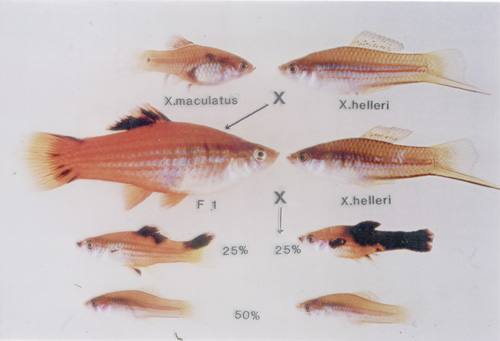
Publications
Some articles, available at Springerlink
- A. Anders: Benignancy and Malignancy and the Significance of Terminal Differentiation in Neoplastically Transformed Cells in the Xiphophorus Melanoma Model Journal of Tumor Marker Oncology, Volume 20 Number 1 Spring 2005
Studies on CECIDOGENESIS and TUMORIGENESIS
- F. Anders Untersuchungen über das cecidogene Prinzip der Reblaus (Viteus vitifolii Shimer)
- Biologisches Zentralblatt 79, 47 - 58, 1960
- Biologisches Zentralblatt 79, 679-700; 1960
- Biologisches Zentralblatt 80, 199-233, 1961
DETECTION of ONCOENES and SUPRESSORGENES
- The Outline of the Xiphophorine Oncogene - Suppressorgene Machinery F. Anders. Tumour formation in Platyfisb-Swordtail hybrids as a problem of gene regulation Expericutia 23, 1-10 1967
-
Localization of Oncogenes and Supressorgenes,, A. Anders, F. Anders, K. Klinke
Regulation of gene expression in the Gordon-Kosswig melanoma system.
- The distribution of the controlling genes in the genome of the xiphophorine tish, Platypoecilus maculatus and Platypoecilus variatus.
- Arrangement of chromatophore determining loci and regulating elements in the sex chromosomes of Xiphophorine fish, Platypoecilus maculatus and Platypoecilus variatus.
- Reflections and Implications on Cancer in Fish and Humans M.R. Ahuja, .F. Anders, Caneer as a Problem of Gene regulation: In . R. Gallo ·(ed:): Recent Advances in Cancer Research; Cell Biology, MolecularBiology, and TumorVirology. CRC Press, Cleveland,Ohio. pp103- 117, 1977
- The Biology of an Oncogene, Based Upon Studies on Neoplasia in X@hophorus , F. Anders. The biology of an oncogene. In: R. Neth R.C.-Gallo, M.F. Greaves, M. Moore, K. Winkler (eds), Modern Trends in Human Leukemia. Springer- Verlag, Berlin, pp 186-206 1983.
- The Molecular Biology of a Suppressorgene F. Anders, M. Schartl, A. Barmekow, C.R. Schmidt, W. Lüke, G. Jaenel-Dess, A. Anders. The genes that carcinogen act upon. In: R. Neth, R.C. Gallo, M.F. Greaves, G. Janka (eds), Modern Trends in Human Leukemia. Springer-Verlag, Berlin, pp 186-206 1985
- Summary of the Work on the Oncogene-Suppressorgene Machinery F. Anders: Contributions of the Gordon-Kosswig Melanoma System to the Present Concept of Neoplasia. Pigment CeU Research 3: 7-29 1991
DETECTION OF A NEW CLASS OF ONCODETERMINANTS
- J. Roushdy, J. Michel, H. Petry, A. Anders, F. Anders. Paragenetic suppressors of suppressorgenes_ J. Cancer Res Clin Oncol 125:123-133 1999
FURTHER MAJOR PUBLICATIONS ON CANCER
- F. Anders. Tumour formation in Platyfish-Swordtail hybrids as a problem of gene regulation. Experientia 23 , 1-10 1967
- A.·Anders, F. Anders, K. Klinke Regulation of gene expression in the Gordon-Kosswig melanoma system
- The distribution of the controlling genes in the genome of the xiphophorine fish, Platypoecilus moculatus and Plalypoecilus variatus.
- Arrangement of chromatophore determining loci and regulating elements in the sex chromosomes of Xiphophorine fish, Platypoecilus maculatus and Platypoecilus variatus.
- M.R. Ahuja, F. Anders Cancer as a Problem of Gene regulation In R. Gallo (ed.): Recent Advances in Cancer Research; Cell Biology, Molecular Biology, and Tumor Virology. CRC Press, Cleveland, Ohio, pp103-117 1977
- A. Anders, F. Anders Etiology of cancer as studied in the platyfish-swordtail system Biochimica and Biophysica Acta 516: 61-65, 1978
- F. Anders, M. Schartl, E. Scholl Evaluation of environmental and hereditary factors in carcinogenesis, based on stjdies in Xiphophorus In: J.C. Dawe et al. (eds). Phyletic Approaches to Cancer, Japan Sci. Soc. Press Tokyo, pp 289-309, 1981
- F. Anders, M. Schwab, E. Scholl Strategy for breeding test animals of high susceptibility to carcinogens. In: H. Stich, RHC San (eds), Short-Term Tests for Chemical Carcinogens Springer-Verlag New York, pp 399-407, 1981
- A. Barnekow, M. Schartl, F. Anders, H. Bauer Identification of a fish protein associated with a kinase activity and related to the Rous sarcoma virus transforming protein Cancer Research 42:2429-2433, 1982
- M. Schartl, A. Barnekow, H. Bauer, F. Anders Correlations of inheritance and expression between a tumor gene and the cellular homolog of the Rous sarcoma virus-transforming gene in Xiphophorus Cancer Research 42:191-275, 1982
- F. Anders, M. Schartl, A. Barnekow, A. Anders Xiphophorus as an in vivo model for studies on normal and defective control of oncogenes Advances in Cancer Res. 42:191-275, 1984
- A + F Anders, M. Schartl, Th. Gronau, W. Lüke, CR Schmidt, A. Barnekow Oncogenes in development, neoplasia, and evolution. In: P. Chandra (ed), ne Experimental Modalities in the Control of Neoplasia. Plenum Press,New York-London, pp15-40, 1986
- Ch. Zechel, U. Schleenbecker, A. Anders , F. Anders v-erbB related sequences in Xiphophorus that map to melanoma determining Mendelian loci and overexpress in a melanoma cell line Oncogene 3:605-617, 1988
- Ch. Zechel, U. Schleenbecker,A. Anders, M. Pfütz, F. Anders Search for genes critical for the early and/or late events in carcinogenesis: Studies in Xiphophorus. In R. Neth, RC Gallo, MF Graeves, G. Gaedicke J. Ritter (eds), Modern Trends in Human Leukemia VIII, Springer-Verlag Berlin- Heidelberg, pp 366-385, 1989
- F. Anders: A Biologist's View of Human Cancer: The Dr. Mildred Scheel Memorial Lecture 1988, Hamburg, Germany In: Modern Trends in Human Leukemia VIII. R. Neth, R.C. Gallo, M.F. Greaves G. Gaedicke, R. Ritter (eds) Springer-Verlag Berlin, pp XXIII-XLV, 1989
- A. Anders, F. Anders, C. Zechel, U. Schleenbecker, A.Smith Ansätze zur Analyse der Initiation von Initialprozessen der Krebsbildung am Melanom-Modell von Xiphophorus. Arch. Geschwulstforsch. 60:249-263, 1990
- G. Clauss, J. Lohmeyer, CV Hamby, S. Ferrone, F. Anders In: S.Ferrone (ed), Human Melanoma, from basic research to clinical application Springer-Verlag, pp74-86, 1990
- F. Anders: Contributions of the Gordon-Kosswig Melanoma System to the Present Concept of Neoplasia. Pigment Cell Research 3: 7-29, 1991
- A.D. Smith, Th. Gronau, A. Pröfrock, Ch. Zechel, I.M. Bird, P.A. Lane, A. Barnekow, F. Anders: EGF-receptor gene, X-src-oncogene, and inositol lipid turnover in key processes preceding melanoma in the Xiphophorus model. In: HT Lynch, RM Fusaro (eds), Hereditary Malignant Melanoma, CRC Press, Boston pp97-109, 1991
- A. Anders, C.Zechel, B.Schlatterer, H.Gröger, D. Schmidt, A. Smith, F. Anders Genetic and molecular approach for breeding and use of laboratory fish for the detection of agents with carcinogenic and/or promoting activity. Bull Cancer 78:415-433, 1991
- A. Anders, H. Gröger, F. Anders, C. Zechel, S. Smith, B. Schlatterer Discrimination of initiating and promoting cercinoens in fish Ann Rech Vet 22:273-294, 1991
- F. Anders: Contributions of the Gordon-Kosswig Melanoma System to the Present Concept of Neoplasia. Pigment Cell Research 3: 7-29, 1991
- C. Zechel, H. Peters, U. Schleenbecker, A. Anders erbB*a: and "Ignition Spark" for the Xiphophorus Melanoma Machinery? In: R.Neth et al. (eds). Modern Trends in Human Leukemia IX. Spinger- Verlag Berlin, Heidelberg , pp 213-234, 1992
- C. Zechel, H. Peters, U. Schleenbecker, F. Anders Expression of genes related to human erbB, erbA, pdgf, and pdgf-r in tumors of different etiolgy in Xiphophorus. Int.J. Cancer 52: 66-75, 1992
- F. Anders, A. Anders, C. Zechel A gene alone may not make a tumor Special Feature, NCI, Aids Research an Human Retroviruses 8: 833-853, 1993
- F. Anders, C. Zechel Oncogenes in Melanoma. In: F.Lejeune, PK Chauduri, T.Das Gupta (eds), Malignant Melanoma (Textbook). McGraw-Hill, Inc. New York, Tokyo pp51-64, 1993
- A. Anders, H. Petry, Ch.Fleming, K. Petry, P. Brix, W. Lüke, H. Gröger, E. Schneider, J.Kiefer, F. Anders Increasing melanoma incidence: Putatively explainable by retrotransposons Pigment Cell Research 7: 1-18, 1994
- F. Anders, Ch. Fleming, H. Petry, K.Petry, W. Lüke, P. Brix, H. Schneider H. Gröger, E. Schneider, J. Kiefer, A. Anders Increasing tumor incidences putatively explainable by retrotransposons. Proceedings XVI Internatl. Cancer Congr., New Delhi, Vol. 1, Monduzzi Editore, Bologna, pp127-131, 1994
- A. Anders, H.Gröger, C. Fleming, H. Schneider, A. Renschler, F. Anders Proceedings XVI Internatl. Cancer Congr., New Delhi, Vol. 1, Monduzzi Editore, Bologna, pp 133-137, 1994
- Ch. Fleming, H. Petry, K.Petry, P, Brix, A. Anders, A. Renschler, H. Schneider J. Kiefer, E. Schneider, H. Gröger, W. Lüke, F. Anders Carcinogenesis and transgenerational accelleration of tumor-incidences in the xiphophorus fish model. In: B. Iyengar, Singh (eds), Growth disorders of the pigment cell.BI Churchill Livingstone, New Delhi, pp 138-156, 1996
- F. Anders, J. Roushdy, A. Anders, C. Fleming, H. Petry, K. Petry, W. Lüke P. Brix, H. Schneider, H. Gröger, E. Schneider, J. Kiefer Prenatal X-ray provoked non-mendelian selfish transgenerational oncodeterminants. In: U.Hagen, D.Harder, H.Jung, C.Streffer (eds), Radiation Research 1895-1995 Vol. 2. Proc. 10th Internat. Congr. Rad. Res. Würzburg, pp 592 ff, 1996
- J. Roushdy, J. Michel, H. Petry, A. Anders, F. Anders. Paragenetic suppressors of suppressorgenes, a new class of oncodeterminants J. of Cancer Research and Clinical Oncology 125:123-133, 1999
Multimedia
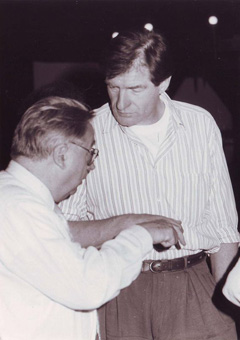
Fritz Anders and Volker Erfle in Wilsede 1990
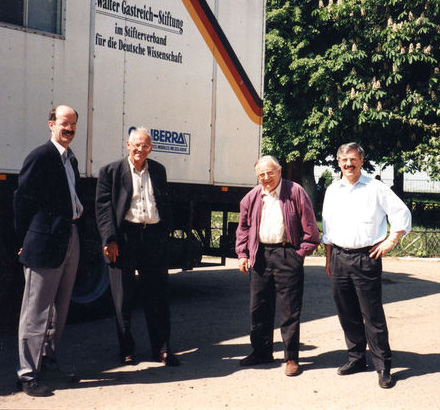
Arnold Ganser, Rolf Neth, Fritz Anders and Karl Welte in Korma
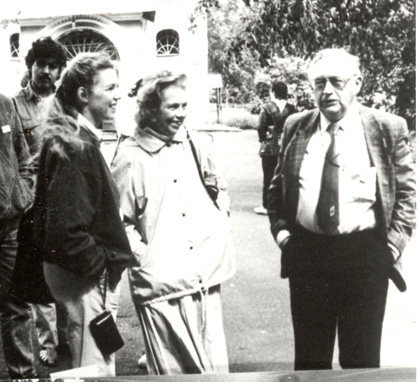
Annerose and Fritz Anders with Elena Frolova in Uglich, 1990
Annerose and Fritz Anders
Over sixty years ago, three investigators, Myron Gordon, Georg Haussler, and Curt Kosswig, working independently, discovered that certain hybrids of the viviparous Central American fish Xiphophor us maculatus (platyfish) and Xiphophorus helleri (swordtail ) develop melanoma, inherited in Mendelian fashion. Subsequently, Gordon and Kosswig showed that the melanomas of the hybrids originated from black spots composed of atypical pigment cells that were contributed by the platyfish to the hybrids. Thirty years later, when Myron Gordon, shortly before his too early death, published his famous review "The melanoma cell as an incompletely differentiated pigment cell" (in M. Gordon, ed., Pigment Cell Biology, Academic Press, New York 1959, pp 215-236), Fritz Anders and his wife Annerose started to utilize this discovery by means of the original fish of Gordon (he bred them on the roof of the Nuseum of Natural History in New York) as a refined experimental system to develop key concepts on genetic, molecular, and environmental events in the formation of this neoplasrn:- Tney composed hybrid fish genotypes which, besides melanoma, developed other types of hereditary neoplasms such as thyroid adenocarcinoma, reticulosarcoma and neuroblastoma.
They summarized their results in that early time of tumor genetics under the title "Tumour Formation in Platyfish-Swordtail Hybrids as a Problem of Gene Regulation" (Experientia 23, 1-10, 1967). Together with numerous associates they went on to~reed tester strains that are sensitive to mutagenic carcinogens, tumor promoters, or both. After treatment with the agents the fish display neurogenic tumors including neuroblastoma, retinoblastoma and other nervous cell tumors, epithelial tumors like thyroid, pancreatic, renal, liver, kidney carcinomas, or mesenchymal neoplasms of connective tissues, muscles and hematopoetic tissues.
As soon as the modern molecular methods became practicable in cancer research, A. F. Anders and their XiDhophorus working group established t he value of the di f ferent strains of the fish, es pecial ly the hybrids with melanoma, in the exploration of cytogenetic, biochemical and molecular lesions associated with neoplasia. They have proposed neoplastic transformation can be traced to a specific gene, present on distinct sites of distinct chromosomes, that they named "tumor gene" (Tu). Detailed analysis at the chromosomal and molecular level has provided evidence for key structural chromosomal changes, as well as alterations of molecular genetic elements that are inherited in parallel with the inheritance of retroviral oncogene-related sequences and in parallel with the switch from the normal to the neoplastic state of the pigment cel ls. Specifically, they have demonstrated" translocations, deletions, and crossovers involving the tumor gene and the corresponding regulatory genes. The concept proposed is that alteration of the regulatory genes is the key to an understanding of carcinogenesis.
This concept is summarized in "The Genes that Carcinogens Act Upon" (in Neth, Gallo, Greaves, Janka, eds., Modern Trends in Human Leukemia VI, Springer-Verlag, Berlin 1985, pp 228-252).
Two generations of investigators have shown in the 60 year s history of the Xiphophorus tumor system that cancer can begin when crucial regulatory genes that normally control genes responsible for cell division and cell differentiation, are lost or mutated in the germ line or in somatic cells. These findings require serious consideration of the possibility that carcinogenic chemicals, radiation, and viruses may actually cause cancer by causing mutations or malfunctions of regulatory genes in somatic cells in humans. Much more serious consideration is required for the possibility that the same changes of regulatory genes occurring in the germinal cells might provoke inherited tendencies to develop neoplasia in humans as the investigators of Xiphophorus have proposed.
Deutscher Krebspreis für Annerose Anders 1993



